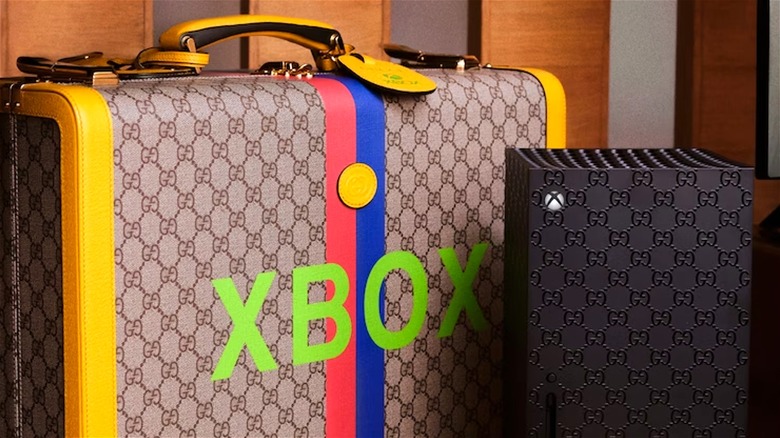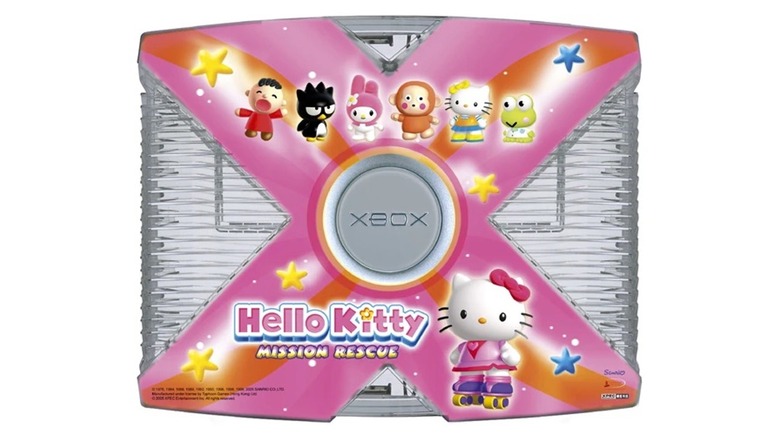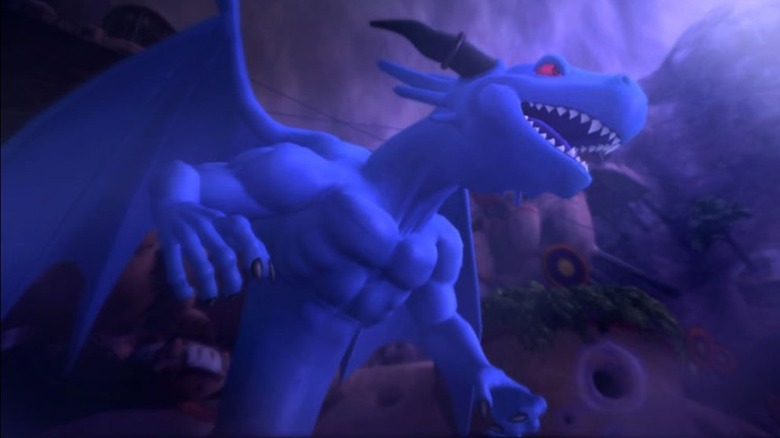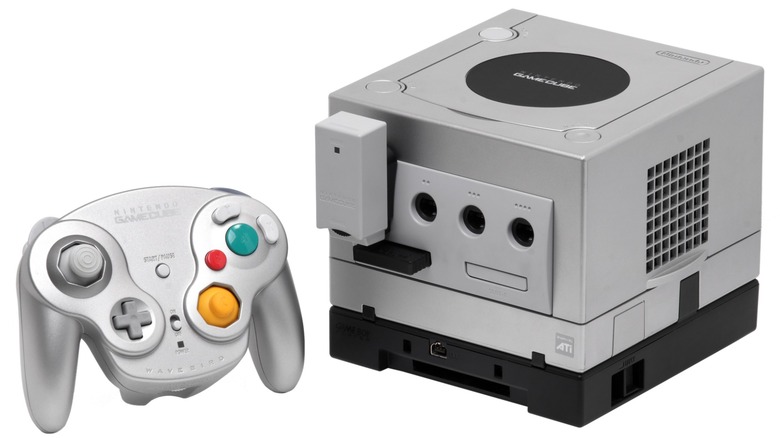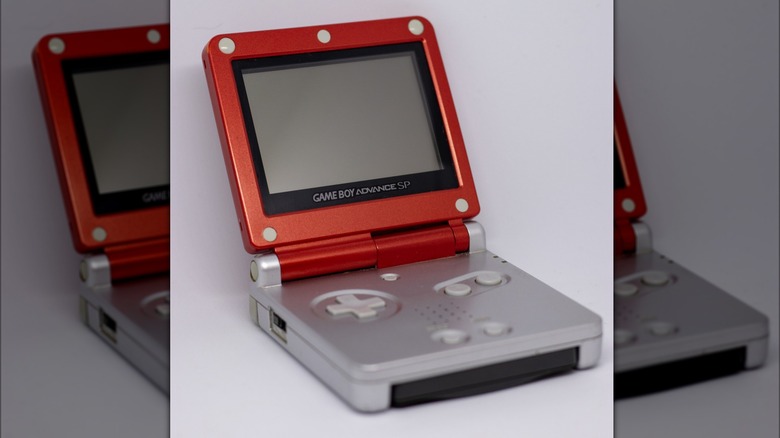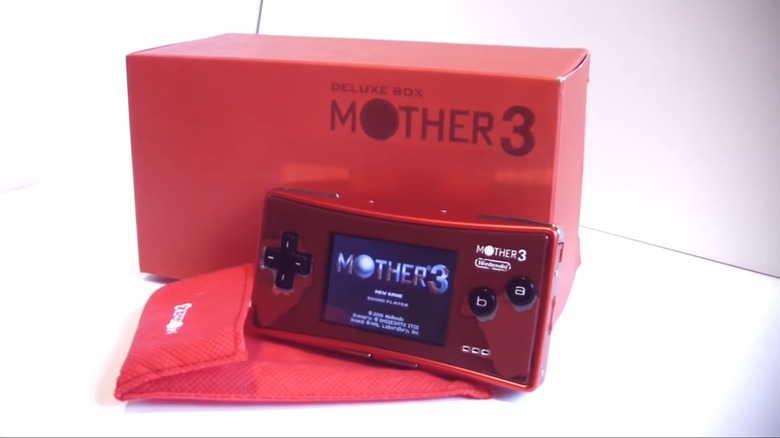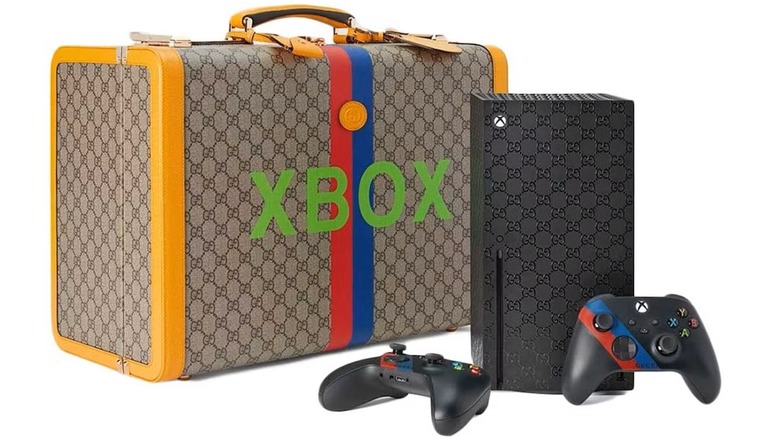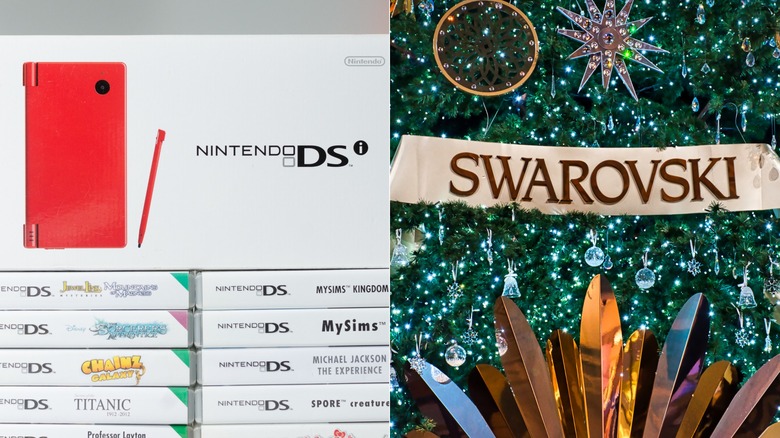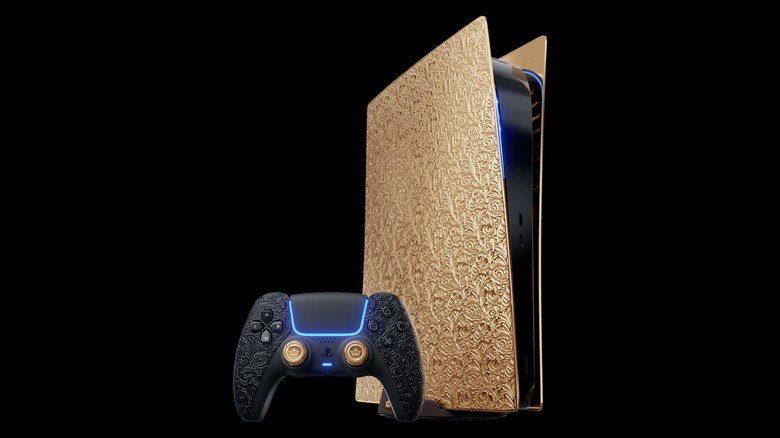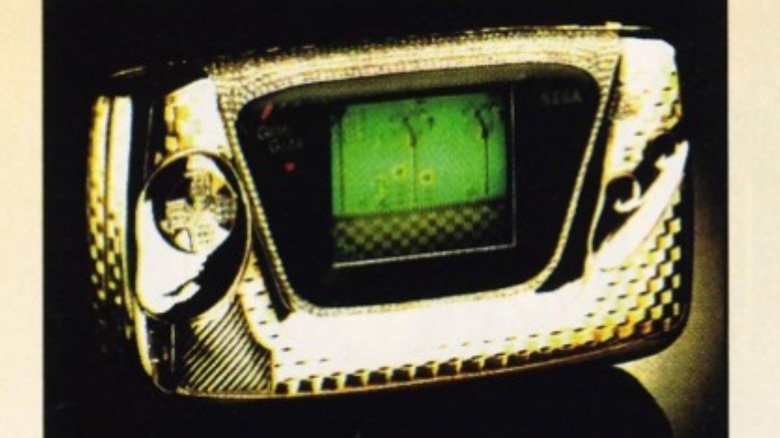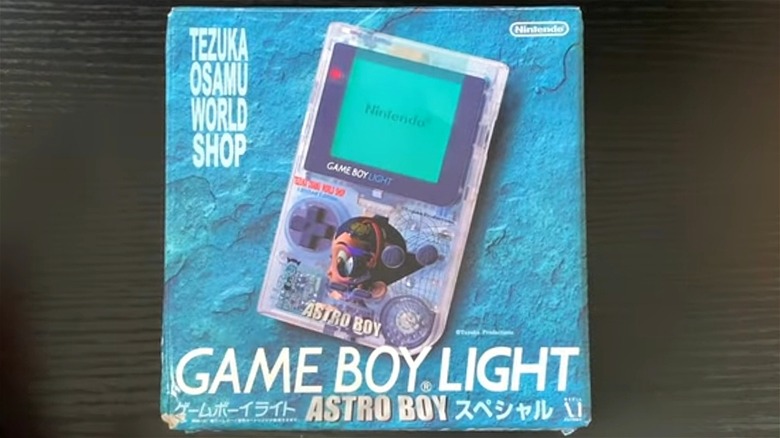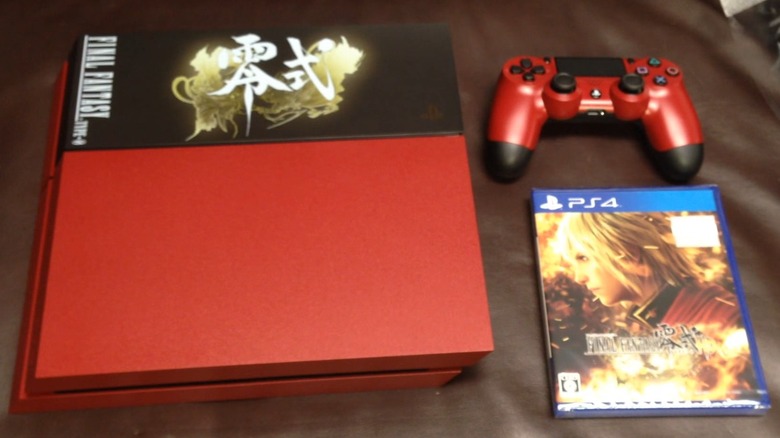12 Of The Worst Collector's Edition Consoles Ever Made
Video games come in many shapes, sizes, and sales tags. The standard price will net you normal consoles and games, but if you spend a bit extra, you get a bit extra.
Collector's editions of games are common, and many include additions such as artbooks, steel CD cases, and even the occasional statue. Collector's editions of consoles, meanwhile, are less common. Usually, they include standard console components — cables, a controller, and the console itself — and a pack-in game, but these bundles set themselves apart from run-of-the-mill consoles with special patterns you can't get anywhere else. If you purchased the "Marvel's Spider-Man" PlayStation 4 bundle, you received a red console sporting Spidey's iconic logo, and if you bought the "Cyberpunk 2077" Xbox One X, you got an Xbox that looks like it belongs in Night City.
Most of the time, limited and collector's edition consoles are well worth the cash, especially if you love the games they come with and their related iconography. However, as with video games themselves, sometimes quality is an afterthought. Maybe the idea behind a limited edition console was sound but the execution was lacking, or maybe the concept itself was flawed. Here are some of the worst collector's edition consoles you are better off not collecting.
Hello Kitty Collector's Pack Xbox
These days, video games are so ubiquitous that almost any kind of game is expected to launch on any contemporary console, and nobody bats an eye when a kid-friendly title like "PAW Patrol Mighty Pups Save Adventure Bay" arrives on Xbox Game Pass. However, that wasn't always the case, which led to some odd special editions from Microsoft.
When the original Xbox was launched, the console was marketed towards older American audiences, primarily male gamers. After all, the Xbox's most famous games included M-rated titles such as "Halo," "Ninja Gaiden Black," and "Dead or Alive 3." The console was released during a time when younger gamers turned to Nintendo, so why would Microsoft market its product towards little girls?
However, capitalism being what it is, in 2005, Microsoft partnered with a shop in Singapore to produce the "Hello Kitty Mission Rescue" bundle. The package included a copy of "Hello Kitty Mission Rescue" (also known as "Hello Kitty Roller Rescue") and a special translucent Xbox with its iconic X plastered in pink and "Hello Kitty" characters. It doesn't sound too bad, especially if it is being bought for a little girl, but the problem was the cost of obtaining the special edition Xbox. Customers couldn't purchase the bundle without buying a $5,000 TV first, which was far too high of a barrier of entry for anyone who wanted to pick up a colorful console for their daughter.
Marlboro Atari Lynx
We're cheating a bit with this entry, but it requires mentioning because it boggles the mind. Just what were the people behind this limited edition thinking?
While Atari produced consoles before Nintendo and Sega, the company had trouble keeping up with its competition later in life. One of Atari's biggest console flops was the Atari Lynx, which also was the company's first and only handheld. The Lynx only lasted a few years and received fewer than 100 games, but Atari wanted the console to succeed so much that they partnered with the cigarette company Marlboro to create a special edition console.
Sometime during the Atari Lynx's life, Atari put together a sweepstakes where people could win a special red Lynx with "Marlboro Abenteuer Team" at the top, as seen in a photo shared on Reddit by u/Sam_Read. To enter, participants had to purchase specially labeled packages of Marlboro Cigarettes and redeem points contained within. Oh, and the console also included a unique pack-in game, "Marlboro Go," that consisted of a man on a motorcycle collecting Marlboro-branded items.
It probably goes without saying what made this limited edition console so bad — it was a handheld aimed at children that encouraged smoking. With business decisions like this, is it any wonder why the Atari Lynx failed and Atari exited the console manufacturing business a few years later?
Blue Dragon Xbox 360
The Xbox never did well in Japan, but not for lack of trying. When Microsoft released the Xbox 360, the company partnered with several Japanese studios, including the then-recently formed Mistwalker, to attract audiences. Unfortunately, these games didn't help the console overseas, despite the fact that many of them were actually pretty good. If only you could say the same about some of their limited-edition consoles.
Mistwalker's first game for Xbox was "Blue Dragon," which was created by a pretty incredible team of developers. The creator of "Final Fantasy" and founder of Mistwalker, Hironobu Sakaguchi, conceptualized and wrote the game. In addition, Nobuo Uematsu, another "Final Fantasy" veteran, composed the music, while Akira Toriyama, who was well known for his work on the "Dragon Quest" series, handled the art for the game. The last time these creative giants collaborated, they developed the seminal SNES classic "Chrono Trigger," so expectations were high. "Blue Dragon" was good, but Microsoft didn't give the same level of love for its limited edition tie-in console.
The special limited "Blue Dragon" Xbox 360 set itself apart from the normal 360 with a faceplate depicting the game's titular Blue Dragon, which can be seen on Consolevariations. Microsoft clearly hadn't quite mastered the art of printing images onto Xbox shells just yet, and the faceplate was ugly even by mid-2000s standards. The Blue Dragon's face was blown up to an excessive degree so it could take up the faceplate, leaving the result looking less like a professional mass-produced item and more like something an amateur console customizer created. The creature didn't even look like Toriyama drew it, which is as damning a criticism as you can get.
Gamecube Platinum
While Nintendo's first few consoles stateside had pretty understated designs, the company eventually learned that audiences love gaming platforms that come in a veritable (and literal) rainbow of colors. Nintendo produced Game Boys and Nintendo 64s in a variety of translucent and opaque hues, and this pattern continued into subsequent game generations, although some became victims of tantamount false advertising.
The Nintendo Gamecube was Nintendo's first foray into CD-based gaming — kinda. Unlike its rivals, the Xbox and PlayStation 2, the Gamecube used miniature optical discs instead of CDs. This feature gave the console a small form factor that, when combined with its proprietary carrying handle and standard purple color, earned it the nickname of "Nintendo's purple lunchbox." Nintendo also produced Gamecubes in black, orange, white, and silver. However, silver, which was officially called Platinum, may have been a huge mistake.
When Nintendo initially produced Platinum Gamecubes, their boxes featured the words Limited Edition, but that label didn't last long. Eventually, Nintendo dropped the Limited Edition claim and just made plain old Platinum-colored consoles. What was the difference between the two? Aside from the box, not much. Some shoppers claimed Platinum Gamecubes were among the most common on the market. While there's nothing objectively wrong with the Platinum Gamecube's color — it actually looks pretty cool — anyone who purchased one under the assumption it would be produced in small batches as the label implied got burned.
Dual Tone Gameboy Advance SP
While many Nintendo handhelds go for a mono-color style, some use two or more, which can look fantastic with the correct theming. The "Legend of Zelda: A Link Between Worlds" 3DS XL, for instance, worked because its gold and black plates were decorated with mirrored Triforces, which tied into the game's loop and themes of swapping between light and dark worlds. The Dual Game Boy Advance SPs weren't so lucky.
The Game Boy Advance SP was a highly popular console thanks to a myriad of features. It was backward compatible and easy to handle, but most importantly, it could fold away to protect its screen and buttons, making it easier to carry in a pocket. Since the console consisted of two shells connected via a hinge, Nintendo got a little experimental with limited editions. Perhaps the best was Classic NES Console Edition, which looked like an NES controller when opened and an NES console when folded away. Creative themes like this resulted in some pretty amazing limited edition Advance SPs, but when the theme was just "different colors," they floundered.
The worst GBA SPs were the Dual Tone editions. These included one that was pearlescent orange and green, photos of which are available on Consolevariation. Instead of looking like official consoles, the handhelds came across as though someone ripped apart two different GBA SPs and surgically reattached their disparate halves. Admittedly, there's nothing wrong with customized consoles, but that's partially because you know what you're getting into. If a professional company produces something that imitates homebrew creations, it comes off as amateurish.
Mother 3 Game Boy Micro
"Mother 3" is the bane of videogame enthusiasts around the world, albeit for different reasons. Outside of Japan, "Mother 3" is the most popular title Nintendo refuses to localize, and inside Japan, it is the subject of a particularly ugly Game Boy.
The Game Boy Micro is a pariah amongst the rest of Nintendo's handheld library. The device lived up to its name by being the smallest Game Boy ever produced (it was about the size of Sega's recent Game Gear Micro), but that palm-sized form factor came at a cost. Unlike other Game Boys, the Game Boy Micro wasn't backward compatible. Also, good luck playing anything on its diminutive 2-inch screen. To celebrate the release of "Mother 3," Nintendo released a limited edition Game Boy Micro that probably needed to go back to the drawing board long before launch.
The limited edition Game Boy Micro "Mother 3" bundle included a copy of the game, some "Mother 3" merch, and a shiny red Game Boy Micro. However, whatever finish Nintendo used on the console doesn't appear very durable since virtually every listing shows the material flaking off around the d-pad, face buttons, and speakers. Also, the "Nintendo" logo on the top right seems to be wearing away — except it isn't.
An unboxing of fresh copies of the handheld posted by the YouTube channel Got2Game reveals that they have the exact same tarnished fronts. Turns out the Game Boys aren't flaking; that's just how the handhelds were designed. It's one thing to make a console resemble a rusted, battle-worn item, as those have a charm to them. The "Mother 3" Game Boy Micro, meanwhile, looks as though Nintendo manufactured the device with inferior paint.
Gucci Xbox Series X
When you're looking for luxurious (and expensive) Italian fashion, look no further than Gucci. All of their items are eye-catching and will set you back thousands of dollars. While Gucci is primarily associated with handbags and clothes, it recently added Xbox consoles to its catalog.
To celebrate 20 years of Xbox and 100 years of Gucci, the two companies collaborated with HYPEBEAST to produce the Xbox by Gucci. Or the Gucci Xbox Series X — either name works. This limited edition consisted of 100 individual numbered Xbox Finally, the bottom of the case was emblazoned with the phrase "GOOD GAME." Why those words? It's because the abbreviation GG just happened to be the same initials as Gucci's founder, Guccio Gucci.
Beauty is in the eye of the beholder, so far be it from anyone to say whether an Xbox inspired by a fashion brand is objectively ugly. However, this limited edition's price tag of $10,000 is objectively outrageous, especially given the prices of Xbox consoles and Gucci travel bags. Plus, unless the light hits the laser-engraved pattern at just the right angle, you would be hard-pressed to notice any differences between the Gucci Xbox Series X and a standard one. For what you get, the Xbox by Gucci is overpriced by a mile.
Nintendo Swarovski
There are many jewelry brands out there, and if you want your item covered in as many diamonds — well, imitation diamonds in this case — as possible, you go with Swarovski. While crystals and other jewels look good on many items, game consoles are not on that list.
Starting in the early 2000s, fans could find Game Boy Advance SPs, Nintendo DSs, and Nintendo Wii consoles covered in Swarovski crystals. At one point, the company also offered a $300 service that let customers customize handhelds with different patterns of Swarovski gems, but these were BYOC — bring your own console. The store also created bejeweled DS Lites and DS Lite covers, some of which were designed by Paris Hilton. Even better, since the Nintendo World Store in NYC joined in on the Swarovski handheld sales, some of these encrusted electronics were officially licensed.
You don't really need to think long and hard about why Swarovski's handhelds were bad. They were covered in imitation diamonds to create patterns. On the one hand, that's just overkill, but on the more important hand, crystals aren't exactly known for having the strongest of bonds with other materials, especially when their surfaces see a lot of palm and finger traffic. Even if buyers put their Swarovski handhelds on display and never played with them, then owners would have had to buy another GBA SP or DS Lite for gaming, which would have raised the question of why they bedazzled their consoles in the first place.
PS5 Golden Rock
If a sweepstakes offers a video game console as a prize, it's not uncommon for the console to be golden. Not covered in gold paint, mind you, but actually made out of real gold. The manufacturers behind these prizes usually don't add extra details to these Midas-touched devices, but they don't need to since a rich shine is enough to attract many participants.
In 2021, the Russian luxury brand Caviar produced two highly limited lines of PlayStation 5 consoles, both of which featured plates of 18-carat gold. The Golden Rock, was assembled from 8 sheets of gold. Instead of making the sheets flat, the Golden Rock lived up to its name with plates that looked like rough golden rocks. Even the Dualsense controllers had golden touchpads and crocodile leather handles. Caviar's other gilded PS5, the Prime Gold, also featured 18-carat gold side plates, although these were embossed with a stylized pattern. It also included a black wood stand and a Dualsense with crocodile leather handles and gold thumbsticks.
While the Prime Gold actually looked okay with the embossed pattern, the Gold Rock's rough plates looked, well, rough. Moreover, 18-carat gold isn't known for durability, so why would anyone use it for thumbsticks, easily the most punished parts of any controller? The Gold Rock's touchpads didn't fare much better since their rocky designs could interfere with the normally smooth component's utility. Also, Caviar's consoles cost over $350,000 each. Need we say more?
David Morris International Sega Game Gear
As previously mentioned, gems and gold generally don't make the best game console decorations. What could be worse than using one bad material? How about both?
During the holiday season of 1993, the British company David Morris International sold what very well might be the world's most expensive Game Gear. This handheld had a shell of solid gold and 46 carats worth of encrusted diamonds. The gold alone weighed 800 grams — about 1.8 pounds — which was double that of your standard Game Gear. How much did this limited edition console cost? An issue of Electronic Gaming Monthly magazine placed the console at £55,000, which came to about $75,000 back then. As David Morris International put it, the golden Game Gear was "the ultimate present for the children of the super rich."
Like the Swarovski Nintendo handhelds, the David Morris International Game Gear's aesthetics were at odds with its purpose. However, these inherent contradictions were much more pronounced due to the addition of gold. Instead of diamonds only covering the shells, the Game Gear's diamond-studded gold covered everything except the screen — even the buttons were golden. Not only did the golden handheld's encrusted diamonds and patterned surface look rough to handle, but since gold is notoriously delicate, owners probably avoided using the console to preserve it, making it another expensive console of questionable functionality.
Osamu Tezuka Game Boy Light
An idea is only the start of a product — what truly makes it sink or shine is execution. You can turn an initially bad idea into a masterpiece with wonderful execution, but likewise, you can ruin a good idea with poor execution.
In Japan, gamers could purchase a special revision of the Game Boy known as the Game Boy Light. This console was Nintendo's first stab at producing a handheld with a backlit screen, and the Game Boy Advance SP eventually stole its thunder. The GBL only lived six months until the Game Boy Color replaced it, so Nintendo didn't have enough time to produce many limited editions. Still, the company managed to squeeze out two GBLs that featured artwork from the father of manga, Osamu Tezuka.
Both handhelds were only available at the Osamu Tezuka World Shop. The first Tezuka GBL consisted of a ruby red body with Tezuka's most famous characters — including Kimba the White Lion, Astro Boy, and Sapphire the Princess Knight — adorning the center. The result was beautiful and a far cry from the other Tezuka GBL, which consisted of a crystal body and a picture of Astro Boy in the center. Unlike the red GBL, the Astro Boy GBL was downright creepy because, for some reason, Nintendo opted for a 3D render of Astro Boy. While it was far from realistic, the image landed in the uncanny valley as the character's oversized eyes didn't look right in 1990s 3D.
Final Fantasy Type 0 PS4
The PlayStation 4 and its Pro and Slim variations had probably some of the coolest special editions ever devised. The oily handprints on the "Death Stranding" edition PS4 Pro were beautifully creepy, and the "Monster Hunter World" edition PS4 Pro showed off the intimidating majesty of the Rathalos. Of course, there's always an exception to the rule.
One of the PS4's worst thought-out limited editions revolved around "Final Fantasy Type 0." The game originated on the PlayStation Portable, but Square Enix didn't start collaborating with manufacturers to produce special edition consoles until the previous console generation. Companies produced two versions: a Japan-exclusive PS4 and a special PS4 and Xbox One that were given away as part of a sweepstakes.
While the sweepstakes consoles were a glorious black covered in a monochromatic version of the "Final Fantasy Type 0" original box art, the actual limited edition didn't hold a candle. Most of this PS4 was a dull red, but one section was black with some "Final Fantasy Type 0" iconography and the word "Final Fantasy" squished into a corner. This design clashed with the console's primary red, and the constricted Final Fantasy words made the design even harder to look at. Had Square Enix and Sony used all of the PlayStation 4's top surface and reserved the bottom shell for the red, the console could have ended up prettier.
